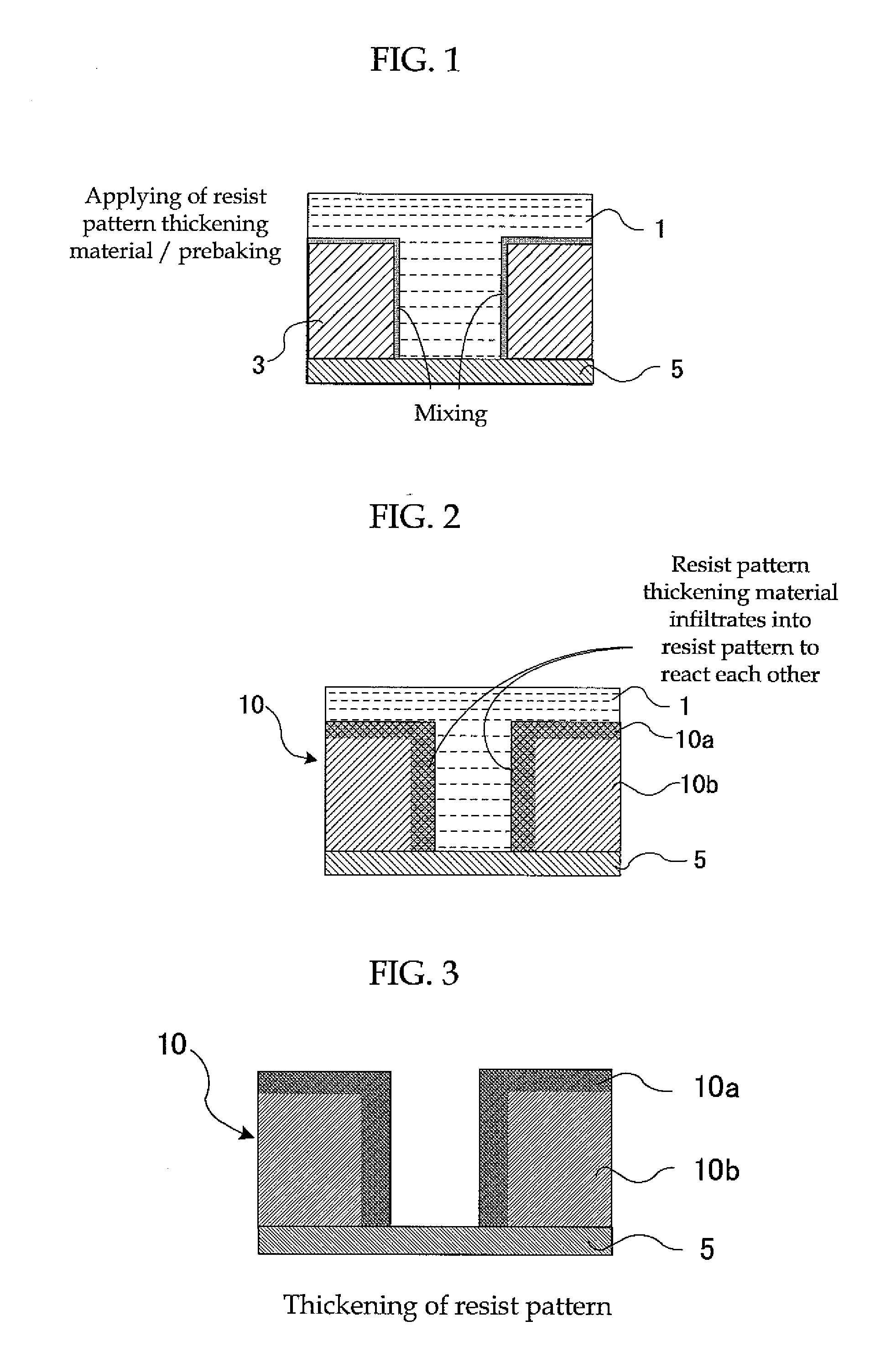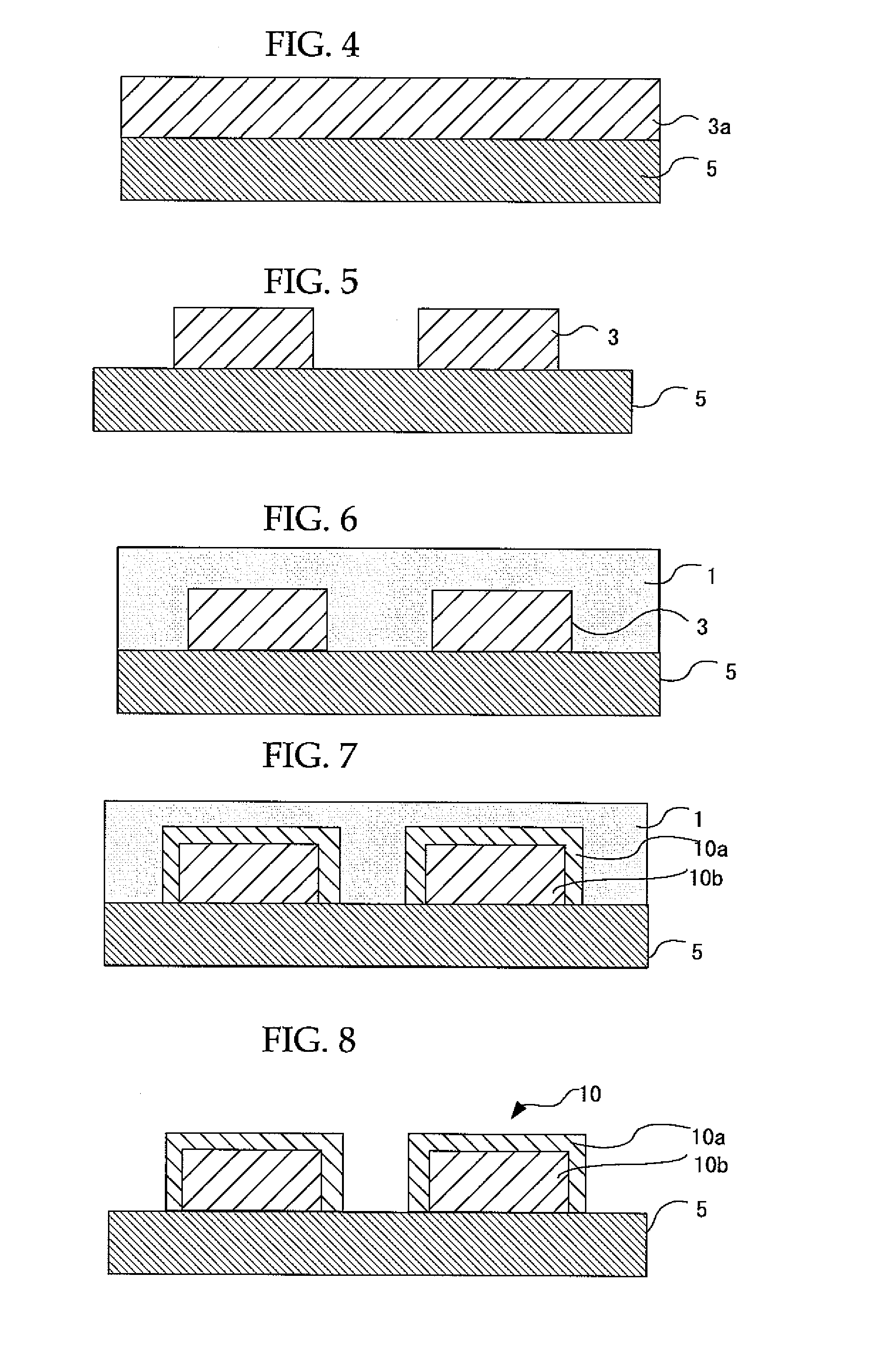Resist pattern thickening material, method for forming resist pattern, semiconductor device and method for manufacturing the same
a technology of resist pattern and thickening material, which is applied in the direction of photomechanical equipment, photosensitive material processing, instruments, etc., can solve the problems of difficult to use such aqueous solution material, difficult to control the amount of reaction, and difficult to set up a new process line for a new chemical agent, etc., to achieve thicken the resist pattern, reduce the effect of etch resistance and less dependency
- Summary
- Abstract
- Description
- Claims
- Application Information
AI Technical Summary
Benefits of technology
Problems solved by technology
Method used
Image
Examples
example 1
Preparation of Resist Pattern Thickening Material
[0148]Resist pattern thickening materials A to O each having a composition shown in Table 1, each of which was a nonaqueous material and contained no acid generator and no crosslinker were prepared.
[0149]Note that “Thickened material” shown in Table 1 means a resist pattern thickening material, and the letters of “A” to “O” respectively correspond to the resist pattern thickening materials A to O. In the resist pattern thickening materials A to O, the resist pattern thickening material A corresponds to a material for Comparative Examples, and the resist pattern thickening materials B to O respectively correspond to materials for Examples of the present invention. The unit of values shown in parentheses in Table 1 is “part by mass” or “parts by mass”.
[0150]In the column “Compound represented by General Formula (1)” for the resist pattern thickening materials B to O, “benzyl alcohol”, “benzyl amine” and “the derivative thereof (a deriva...
example 2
Formation of Resist Pattern
[0155]Each of the resist pattern thickening materials A to O prepared in Example 1 was applied over a surface of a hole pattern which had been formed from an ArF resist (“AR 1244)”, manufactured by JSR CORPORATION), the hole pattern having an opening diameter described in the column “Size of unthickened space pattern of resist (before thickening)” in Table 2, by a spin-coating method under the conditions of 1,000 rpm / 5 s initially, and subsequently, 3,500 rpm / 40 s. Then, the each of the applied resist pattern thickening material was baked under the condition of 110° C. / 60 s. Next, each of the applied resist pattern thickening materials A to E, J, K, L and N was rinsed with 2.38% by mass of a TMAH alkali developer for 60 seconds and further rinsed with pure water for 60 seconds, and each of the applied resist pattern thickening materials F to I, M and O was rinsed with pure water or 2.38% by mass of a TMAH alkali developer for 60 seconds and further rinsed ...
example 3
Formation of Resist Pattern
[0158]Each of the resist pattern thickening materials D and G prepared in Example 1 was applied over a surface of a lines & spaces pattern which had been formed from an ArF resist (“AR 1244)”, manufactured by JSR CORPORATION), the lines & spaces patterns respectively had a space portion having a varied size (the size described in the column “Size of unthickened space pattern of resist (before thickening)” in Table 2, i.e., 110 nm, 200 nm, 300 nm, and 500 nm), by a spin-coating method under the conditions of 1,000 rpm / 5 s initially, and subsequently, 3,500 rpm / 40 s. Then, the each of the applied resist pattern thickening material was baked under the condition of 110° C. / 60 s. Next, the applied resist pattern thickening material D was rinsed with 2.38% by mass of a TMAH alkali developer for 60 seconds and further rinsed with pure water for 60 seconds. The applied resist pattern thickening material G was rinsed with pure water for 60 seconds and further rinse...
PUM
| Property | Measurement | Unit |
|---|---|---|
| wavelength | aaaaa | aaaaa |
| boiling point | aaaaa | aaaaa |
| time | aaaaa | aaaaa |
Abstract
Description
Claims
Application Information
 Login to View More
Login to View More - R&D
- Intellectual Property
- Life Sciences
- Materials
- Tech Scout
- Unparalleled Data Quality
- Higher Quality Content
- 60% Fewer Hallucinations
Browse by: Latest US Patents, China's latest patents, Technical Efficacy Thesaurus, Application Domain, Technology Topic, Popular Technical Reports.
© 2025 PatSnap. All rights reserved.Legal|Privacy policy|Modern Slavery Act Transparency Statement|Sitemap|About US| Contact US: help@patsnap.com



